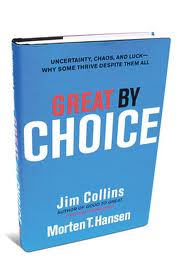 In looking at books to review for our end of year edition, we found Great by Choice to be the kind of motivating book that lends itself to end of year reflection and inspiration. Jim Collins is known for his best-selling business book Good to Great (2001), which studied what made companies great over an extended period of time according to seven defining characteristics. Collins has followed up with a sequel, written in collaboration with Morten T. Hansen, a professor at Berkeley. The authors use the expeditions of Roald Amundsen and Robert Scott to the South Pole in the early 20th century as examples of how companies can succeed or fail. Scott was unprepared and overreaching on optimal days and lost ground on bad days, which ultimately led to the deaths of him and his team. Amundsen took great pains to be prepared and looked at all possible worst case scenarios that could befall him. Amundsen’s theory was that you prepare with intensity all of the time, so that you have strength to draw on in adverse conditions.
In looking at books to review for our end of year edition, we found Great by Choice to be the kind of motivating book that lends itself to end of year reflection and inspiration. Jim Collins is known for his best-selling business book Good to Great (2001), which studied what made companies great over an extended period of time according to seven defining characteristics. Collins has followed up with a sequel, written in collaboration with Morten T. Hansen, a professor at Berkeley. The authors use the expeditions of Roald Amundsen and Robert Scott to the South Pole in the early 20th century as examples of how companies can succeed or fail. Scott was unprepared and overreaching on optimal days and lost ground on bad days, which ultimately led to the deaths of him and his team. Amundsen took great pains to be prepared and looked at all possible worst case scenarios that could befall him. Amundsen’s theory was that you prepare with intensity all of the time, so that you have strength to draw on in adverse conditions.
The authors found this kind of discipline in the companies that succeeded in their research. Like Good to Great, this book keeps your attention and is an interesting read. Based on the Amundsen-type approach to success, the authors build their theory of successful leaders and companies around broadly stated attributes of discipline and preparation. They found that creativity and innovation were not as important as relying first on empirical evidence and observation. Bold moves had to be made from an empirical base. While this is sound advice in our current economy, not all innovative entrepreneurs might agree. Herb Kelleher of Southwest Airlines, serves as a good example of the authors 10X-type leader, whose preparedness before 9/11 and the recession left him standing when other airlines fell. Even Southwest’s funny and scaled-down approach was borrowed from Pacific Southwest, an airline no longer in existence. Kelleher backs up the book’s theory that discipline ranks first above creativity. Where this theory gets somewhat murky is with Steve Jobs. The authors describe his comeback as fitting into their theory, where earlier, they found Bill Gates to be ahead of Jobs in discipline and success. In fitting with their theory, they claim that Jobs got Apple back on track by first focusing on discipline, not the iPod or iTunes; that all came after the discipline.
If you read Isaacson’s Steve Jobs, reviewed in our last issue, you will see that Jobs was much more complex an individual and business leader to fit into any broad model of success. Still, the authors make valid points and posit a theory that is worthy of attention. While focusing on discipline, this book offers inspiration, especially in an economic environment that is less than rosy. The end of the book addresses the concept of luck and ultimately summarizes that most successful 10X companies were not affected more or less by luck, rather they used the luck they had to positively move forward. When faced with bad luck, they were ready to rise above the chaos. The authors state that we are not imprisoned by our circumstances and are free to make the decisions to become great. Now, that’s a good start for end of year reflection!


